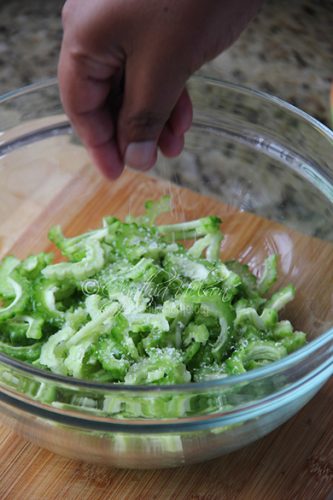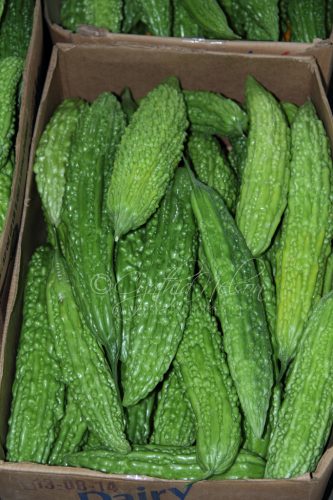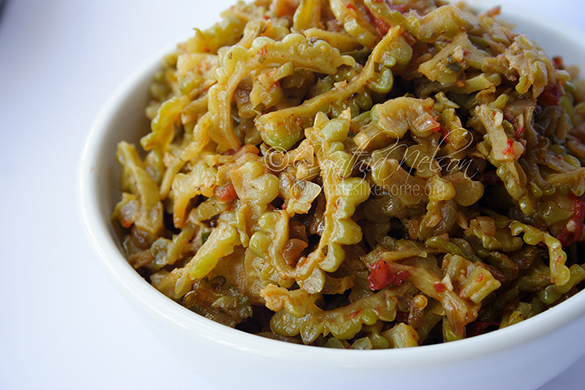
“I cooked fry karaila last week and the entire pan of karaila turned to mush! How come the karaila I ate from you was different?” That was the question I got from a friend of mine last weekend.
Karaila, also known as bitter melon, bitter gourd, and bitter squash among other names, belongs to the cucumber family and cucumbers as we all know are mostly water; 95 percent actually. Karaila, being a member of the same tropical family is 91 percent water. Therefore, it is understandable that unless treated in a particular way, prior to cooking and/or actual cooking, the vegetable is likely to soften to the extent that when tossed or turned, it melts, becoming almost spreadable. Personally, I do not really believe that there is a right or wrong way to cook karaila, it comes down to a matter of personal preference. And frankly, all of us prefer certain things cooked in particular ways to yield specific textures and flavours.

I grew up seeing my mother slicing the karaila into half-moon slices after removing the tips and seeds; salting the lot and letting it rest for about an hour. This process was to extract most of the bitterness from the karaila. She would squeeze the karaila dry with her hands, yielding a rich green juice and then torture us, her children. She’d line us up, side by side, and me being the eldest always had to suffer first by drinking the bitters. Oh, the faces we made and the dislike we felt in those moments. We were “rewarded” when she remembered or felt like it, with a pinch of sugar after downing the bitters.
Salting the sliced karaila is to remove the excess bitterness from the vegetable. Once it is salted, let it sit for about an hour on the countertop, at room temperature. Do you recall how once you add salt to a sliced cucumber, it quickly begins to lose its crisp texture and yields water? Well the same thing happens with karaila. The water in this case, is the bitter juice being extracted as it sits. The karaila, once the excess liquid is removed, loses its shape and plumpness. On the other hand, if you are like me, and embrace the full bitterness, then you can eliminate this step of salting, resting, and removing the excess moisture from the karaila. Regardless of your preferred approach, this next step is important to ensure that your karaila, does not cook up mushy.

Spread the sliced karaila on to a baking sheet or large platter in a single even layer and let it dry. If there is sun where you are, and you had salted the karaila and removed the excess moisture, then put it to dry for about 30 to 45 minutes. You will notice that it has shrunk, that’s fine, it will cook up a little crisp and still tender. However, if you did not salt the karaila, put it in the sun to dry for an hour to an hour and 15 minutes (the time is longer because there is more moisture). And what you are doing here is concentrating the bitter flavour of the karaila, which is how I like it. The karaila will look a little pale in colour, shrink, and the edges somewhat white – this is normal. I repeat for emphasis, regardless of which approach you take, drying the karaila prevents it from softening to the point that it melts when cooked. Feel free in either case to leave the karaila to dry for longer if you like but not for more than 1½ hours if salted or for 2 hours if unsalted (in the sun).
Proceed to cook the karaila as you normally would, however, if you salted your karaila in the preparation stage, then there will be no need to add more salt to the dish. If you are cooking it with meat, chicken, or seafood, then only add salt to season those items and bear in mind that the karaila is already salted. On the other hand, if you did not salt your karaila, only add salt to season the karaila towards the end of the cooking process; this is to prevent the karaila from releasing any moisture that can alter its texture.
Here’s a tip: try to avoid tossing or turning the ingredients too much in the pan; the frequent and constant agitation can cause the release of moisture which will then mean that the food needs to cook longer until all the liquid has dried out, at which time, not only is everything overcooked but the texture is not pleasing.
Cynthia





